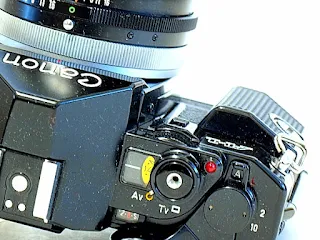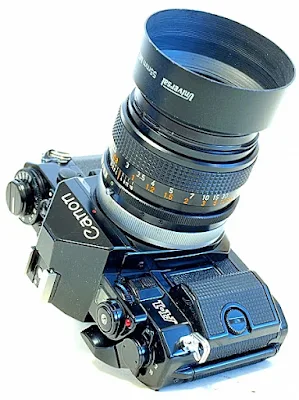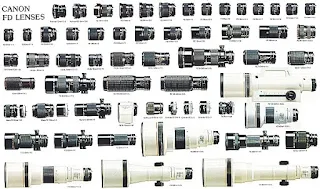The Vintage Enthusiast: A look back at the first manual focus 35mm autoexposure SLR film camera with a Programmed AE mode from Canon.
Canon set the trend for microprocessor-equipped SLRs with the FD Breachlock-mount A-series 35mm SLR film cameras with the Canon AE-1 (1976), Canon AT-1 (1976), Canon A-1 (1978), Canon AV-1 (1979), Canon AE-1 Program (1981), and Canon AL-1 (1982), a 'Quick-Focus' 35mm SLR film camera.
Significant among these SLR film cameras was the advanced-level Canon A-1, the first camera to have a Programmed AE mode, which enables the camera to select both shutter speed and lens aperture opening automatically for perfectly exposed images.
Expanding on what was available on the Shutter-Speed Priority AE-1, the A-1 is equally capable of shooting in Aperture Priority AE, Shutter-speed Priority AE, Manual Exposure, Stopped-down AE, and AE Flash with specified Canon flash units.
The A-1 was a great success, a runaway best seller for Canon, and often referred to as one of the most modern-looking cameras of the 1970s. Often touted as 'Canon's Best SLR', the A-1 is still trending well among film photo enthusiasts and camera collectors. As valid today as the day it was first launched, the Canon A-1 is one to own and keep.
Introduction to the Canon A-1 -- Video 1 of 3
Canon released the A-1 as part of the revisioned A lineup -- A, AE, AE Program, AT, and AV. The A-1 included numerous features new to the camera and still la...
The success of the Canon A-series cameras was supported by an equally strong suite of Canon FD lenses, one of the most extensive collections of manual focus lenses ever produced. The range totals 134 in all, covering from 7.5mm to 1,200mm, through a series of seventeen fixed focal lengths and nineteen zoom range lenses.
The A-series cameras and Canon FD lenses stayed in production until 1987.
Design and Built
The Canon A-1 is an advanced level Programmed AE 35mm SLR film camera fitted with a horizontal cloth-curtain focal-plane shutter with an electrically controlled speed range of 30 to 1/1000 second, plus B and a flash synchronization speed of 1/60 second.
Camera operation is switch controlled, the shutter release is two-step electromagnetic, metering is TTL (Through the Lens) center-weighted, Film ISO speed is 12 to 12800 in 1/3 steps increment, and Exposure Compensation is +2EV at 1/3 steps. The camera is also equipped with a switch-selectable 10-second delay self-timer and DOF (Depth-of-Field) preview facilities.
Exposure modes executable are Programmed AE, Aperture Priority AE, Shutter-Speed Priority AE, Manual Override, Stopped-down AE, and AE flash photography with specific Canon flash units. The camera accepts Canon FD breech-lock mount lenses with full-aperture metering, and FL and non-FD lenses with stopped-down metering.
The focusing screen is a standard split-image/microprism rangefinder with 95.3% horizontal and 93.4% vertical coverage of the actual picture area. The Canon A-1 body weight is 640 grams body only, 875 grams when fitted with a Canon FD 50mm f/1.4 lens.
Basic Camera Features
'Canon's Best SLR', the Canon A-1 is available only in black.
The sophistication of the Canon A-1 starts with the front panel of the camera body, which houses the lens mount, the Stop-Down Lever located on the lower right of the front panel, a PC socket on the front of the top plate, and on the vertical of the lens mount housing, the Exposure Review Switch, and the AE Lock Switch (Exposure Memory Switch).
The left front of the camera is occupied by the Battery Chamber, the Action Grip, which you have to remove (unscrew) to access the Battery Chamber Cover when replacing the battery, and the A-1 Dial, the dial for setting the exposure modes of the A-1, and the AT dial guard lever mechanism.
On the left of the top plate is the Film Rewind Crank, which is also the Pull-up Film Back Release, sitting on top of the integrated Film ISO and Exposure Compensation dial. The Exposure Compensation lock is a small knob towards the back of the top plate, while the film ISO selection release is a very small knob, located towards the top left corner of the top plate, placed on the outer ring of the dial. Towards the front of the top panel is the Viewfinder Display Lever, which is used to set the LCD display in the viewfinder On, or Off.
An accessory shoe sits on top of the pentaprism, and on the right of the top plane, the AT Dial mechanism, Battery Check/Self Timer LED the 4-position power switch, Film Forward Crank, Multiple Exposure Lever, and Film Frame Window. The AT Dial mechanism is a section on its own, later in this presentation.
The back of the camera is plain except for the interchangeable hinge-type film back with a Film Tab Holder, the Viewfinder Eyepiece, and the Eyepiece Curtain Lever, a nifty idea usable for those long night shots.
On the bottom of the camera are the Winder Coupling Cover, Winder Guide Pin Slot, Film Rewind Release, Tripod Socket, and Winder Contact Terminals.
The film box is a standard easy-load Film Chamber, Shutter Curtain Window, Film Advance Sprocket, and Multi-Slot Take Up Spool configuration. Film advance is also the standard two-blank shots for the film lead to be advanced to frame 1.
The Canon A-1 AT Dial
The heart of the A-1 is what Canon calls the AT Dial, which is quite a contraption, and sits on the top plate as a housing for the Cable Release enabled Shutter Release Button, which is positioned on its apex.
Just below the Shutter Release Button is the AE Mode Selector dial, with which you can choose to go Av (Aperture Priority AE) or Tv (Shutter-Speed Priority AE). The dial is located beside the AE Mode Display window which will display further selectable options based on the AE Mode you select.
If your selection is Av (Aperture Priority AE), where you set the lens aperture you want to work with and let the camera choose the shutter speed, the AE Mode window will display a lens aperture dial, with markings from f/1.2 to f/22 in 1/2 steps increments. The selection of the aperture setting is by the AT Dial located on the front of the top plate, again within the vicinity of the Shutter Button housing.
If you decide to go to Tv (Shutter-Speed Priority AE), the AE Mode window will display the shutter speed dial and the 'P' icon for your selection. Selecting 'P' means you are going into Programme AE Mode where the camera will decide on the best shutter speed/aperture setting for the perfect exposure. Moving the dial to any of the shutter speed settings means that you are going into the Shutter-Priority Mode where the camera will automatically decide on the lens aperture opening.
Going Manual Exposure means that while you are still in Tv (Shutter-Speed Priority AE) mode on the AT Dial, you will rotate the lens aperture dial on the lens barrel away from the 'A' and set the aperture opening to the one you want to be working with. This override means that you are now in control of both the shutter speed and the aperture opening of the lens.
The AT Dial is protected by the AT Dial Guard, a push-up push-down slide cover located on the front top panel of the camera body. When pushed up, the guard will block access to the AT Dial.
The best part of understanding the functionality of the AT Dial is that once you understand the basics of this setup, you will have almost mastered the whole technicality of using the Canon A-1. All that waits, for now, is your creativity.
Viewfinder Readout
Viewfinder info of the 95.3% horizontal and 93.4% vertical coverage is a simple image of the framed view, and a horizontal analog LED readout in red lettering along the bottom of the frame. The bar displays the shutter speed on the left (first 4 digits), and lens aperture data (middle 2 digits), both in 1/2 stop increments. On the right, a mode display for camera control - M, Bulb, F, bu F, EEEE, EE.
Exposure Modes
- Programmed AE - The mode to introduce you to the simplicity of using the A-1. Set the AT Mode Selector to Tv (Shutter-Speed Priority AE), adjust the AT Dial 'P', set the aperture ring setting on the lens barrel to 'A', and you are ready to go.
- Aperture Priority AE - Set the AT Mode Selector to Av (Aperture Priority AE), adjust the lens aperture dial to what you want to shoot in, retain the aperture ring setting on the lens barrel to 'A', and go ahead with your DoF (Depth-of-Field) and 'good bokeh' shots.
- Shutter-Speed Priority AE - Set the AT Mode Selector to Tv (Shutter-Speed Priority AE), use the AT Dial to set the shutter speed to what you want to shoot in, retain the aperture ring setting on the lens barrel to 'A', and continue on to be the speed freak you have always wanted to be.
- Manual Exposure - Take your creativity a step up the ladder in Manual Exposure mode. You are in control of both shutter speeds. Set the AT Mode Selector at Tv (Shutter-Speed Priority AE), and the lens aperture to your own setting to take, for example, low- or high-key shots, or shots in extreme lighting conditions.
- Stopped-down AE - Exposure measurement will be taken in the same setup condition, and it does not matter if you are in Av (Aperture Priority AE) or Tv (Shutter-Speed Priority AE) mode.
- Flash AE - The Canon A-1 works with Speedlites 199A or 155A for Flash AE shots. For these shots, the lens aperture setting is still set to 'A' and you can shoot in Av (Aperture Priority AE) or Tv (Shutter-Speed Priority AE) mode.
Exposure Compensation
Exposure Compensation is available on the Canon A-1 at ±2EV stops in 1/3 steps, used normally in unusual or special lighting conditions.
Exposure Memory Switch
The Exposure Memory Switch, which is likely the first generation of the AE (AutoExposure) Lock found on current cameras, is quite cumbersome to use. To activate the lock, you have to half-press and hold the shutter release button to activate the exposure meter, then with the index finger of your left hand, press and hold the Exposure Memory Switch (located on the right vertical of the lens housing mount) until you take the shot. The Exposure Memory Switch does not lock.
Multiple Exposure
Multiple exposures are activated by pushing back the small Multiple Exposure Lever located almost below the Film Advance Crank backward until it locks before cranking the advance lever forward. You need a bit of dexterity of the hand to do it seamlessly here.
Battery And Battery Check
The camera requires a 6V 4SR44, PX28A, A544, K28A, V34PX, 4LR44, or L544 alkaline battery to power its operation. The camera won’t work without a battery though, as it needs the power to release the shutter and for the metering system to work, and I suppose it doesn’t hurt to keep a spare battery handy.
The battery is still strong when the battery check LED displays a sequence of rapid flashes and needs to be replaced as the flash slows down to three or fewer per second. To conserve the battery, you can turn off the viewfinder LED display. The AE function of the camera will still function normally with the display turned off.
Using The Camera
The Canon A-1, as we know it, is a highly acclaimed and acknowledged 35mm SLR film camera of the '80s. Introduced in 1978, the A-1 was one of the historically significant cameras of the 35mm SLR era, as the first SLR to offer electronically-controlled Programmed AE (auto-exposure), a computerized system that enables the camera to choose a shutter speed and aperture setting combination that will result in a perfectly exposed image.
Not limited to the Programmed AE mode alone, the A-1 was also incorporated with the ability to shoot in all the now-standard shooting modes - aperture priority, shutter priority, and full manual -features that we see on virtually every camera in production today. The A-1 started it all, that was the strength of the camera then, which also set it apart from the other A-series cameras, and is still the strength of the camera today.
The fairly compact body is neither too much of a strain on your hands nor on your neck, and it has a large and clear viewfinder that adds to the confidence of using one. Solid and sure as it looks and feels, its build quality, the strength of construction, and the gorgeous design which is only available in black will only add to the deliciousness of owning and using one.
The A-1 is also an excellent choice for its wealth of features that are not easily found in other SLR film cameras of the same era. At the enthusiast level, it has even better functions and functionalities than the consumer-orientated AE-1 Program itself. The system is also accompanied by a large depository of Canon FD prime and zoom lenses that are easily available at equally affordable prices, which will surely help advance your photography skills and creativity as well.
Minor quirks aside, the A-1 is a beautiful machine. It looks great, it works great, and it turns heads. If you thinking about getting one, sans the thought, just go and get it.



























I have used the Canon A-1 in my youth and it was one of the best cameras in my life, besides the T90, EOS-3/AE2 and the EOS 5D Mark III.
ReplyDelete